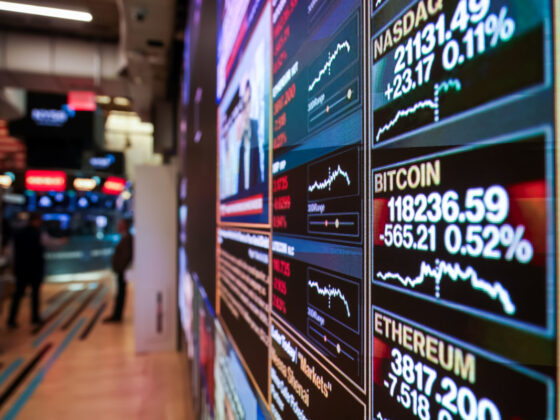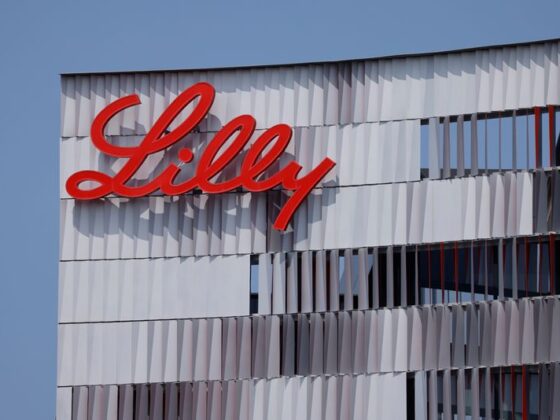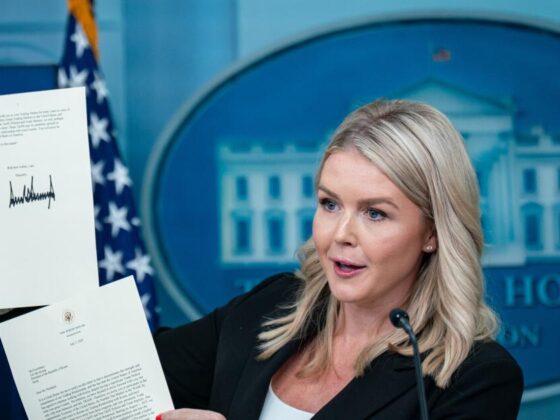Closing summary: Stronger US GDP figures, but weaker underlying growth
It is a stronger-than-expected US GDP reading, but it does not quite paint the picture that the headline numbers might suggest – or indeed the picture that Donald Trump believes.
US GDP grew at a 3% annualised rate, according to the US Bureau of Economic Analysis, but that reading was distorted the numbers.
Trump’s tariffs caused a big surge in first-quarter imports (by definition depressing the GDP reading) and a big drop in imports in the second quarter (which artificially boosted it.
Oliver Allen, senior US economist at Pantheon Macroeconomics, a consultancy, said:
Don’t be fooled. Underlying growth was weak in the second quarter and took a material step down in the first half of this year compared to 2024.
Underlying growth in the second quarter may be around 0.5%, Allen said.
We think a GDP print close to that pace is likely in the third quarter, given the mounting headwinds for the economy, and we see growth remaining weak in the fourth quarter too.
But do not expect the Federal Reserve to try to stimulate further economic growth. It would be a shock if it did anything other than leave interest rates on hold at its announcement later today, and the timing for a first rate cut is uncertain.
Lindsay James, a strategist at Quilter, an investment manager, said:
With tariffs still a threat to the future path of inflation, despite the recent run of CPI coming in lower than expected, and an economy that remains to hold up against all the pressures it faces, the Federal Reserve is likely to continue to resist pressure to cut interest rates until there is a greater clarity about how shifting global trade dynamics will ultimately impact consumers wallets.
Until the economy obviously rolls over and struggles, Trump will be left waiting for his long desired interest rate cuts.
You can continue to follow our live coverage from around the world:
Thank you as ever for following today. Join me again tomorrow morning for European market reaction to tonight’s Federal Reserve announcement. JJ
Key events
The US dollar has strengthened against the euro, leaving the European currency at a five-week low.
The dollar has depreciated markedly during 2025, partly as a result of Donald Trump’s upending of the global trading system making US assets relatively less attractive. However, that trend has reversed in the last week.
The euro was down by 0.8% on Wednesday afternoon, as investors adjust to the expectation of higher US interest rates (which tend to result in currency appreciation).
Sarah Butler
Depop, the London-based secondhand clothing marketplace, is on track for $1bn of annual sales for the first time, its owner Etsy has said, after a 35% surge in sales to $250m in the three months to 30 June.
The company said growth was driven by a 54% jump in sales in the US as it signed up a record number of new shoppers.
Growth at the business reflects a surge in interest in ‘pre-loved’ clothing in recent years with rival Vinted reporting a 41% rise in sales to almost €813m for 2024 with profits almost tripling to €95.4m after the company stepped out of the red for the first time in 2023.
The strong sales at Depop were revealed as its parent group reported a near 5% drop in sales to $2.8bn in the quarter as it saw a decrease in active buyers at its main Etsy marketplace, which focuses on handmade and bespoke products. Net profits for the group dived $24m to £29m, largely because of a loss on exchange rates.
The company did not say if it had been affected by changes in the US tax regime under which imported items worth less than $800 being sent direct to consumers must now pay import tax.
Wall Street shares are pretty flat at the start of trading on Wednesday in New York.
Here are the opening snaps, via Reuters:
-
S&P 500 UP 4.84 POINTS, OR 0.08%, AT 6,375.70
-
NASDAQ UP 40.33 POINTS, OR 0.19%, AT 21,138.63
-
DOW JONES UP 14.09 POINTS, OR 0.03%, AT 44,647.08
Donald Trump is exhibiting an… unorthodox approach to monetary policy.
In a post on Truth Social, the social network he owns, Trump argued that the Federal Reserve should cut interest rates because of faster-than-expected growth.
That is the exact opposite of how the vast majority of economists think about interest rate changes: they usually consider higher interest rates when economies grow faster, in order to prevent inflationary pressure building.
Trump posted:
2Q GDP JUST OUT: 3%, WAY BETTER THAN EXPECTED! “Too Late” MUST NOW LOWER THE RATE. No Inflation! Let people buy, and refinance, their homes!
It is not the first time a world leader has gone for unorthodox monetary policy theories: Turkey’s president, Recep Tayyip Erdogan, argued for a period that higher interest rates cause inflation. That theory did not gain much traction.
The US economy is still growing under Donald Trump’s presidency, but at a slower rate than last year under Joe Biden. Atakan Bakiskan, US economist at Berenberg, an investment bank, said:
Since the start of the year, US economic activity has expanded by 1.2% annualised, much slower than last year’s odds-defying first-half performance of 2.3% annualised. This softer growth path will likely persist – courtesy of slower immigration, trade wars and an uncertain macro environment.
But for future interest rate decisions the Federal Reserve is likely to deprioritise the GDP figures in favour of the jobs data due to be released on Friday. Bakiskan again:
Given the lag and the noisy signal it sends, GDP will remain in the backseat. The Fed will stay focused on what sits in the front seat – the holy grail nonfarm payroll data – to assess the health of the US economy. That has so far proved resilient so far and should remain so on Friday. With only a few hours left until the Fed decision, which is all but guaranteed to be a hold, today’s GDP report will not change the narrative of a slowing but not stalled US economy.
There are signs of weakness in the US economy below the surface of the faster-than-expected second-quarter growth, according to Thomas Ryan, a North America economist at Capital Economics, a consultancy.
He wrote:
The 3.0% annualised gain in second-quarter GDP overstates the economy’s underlying strength, as it was largely driven by a 30% slump in imports as pre-tariff stockpiling unwound. The more worrying development was that growth in sales to private domestic purchasers slowed to just 1.2%, its weakest since late 2022.
Net trade swung from a 4.6%-point drag on first-quarter GDP growth to providing a 5.0%-point boost last quarter, driven by a sharp drop in imports as firms shifted from front running tariffs to working through existing stockpiles.
Consumption growth did accelerate – albeit to a slower pace than previous years. Ryan said that the consumption growth “demonstrates that all the tariff uncertainty last quarter did not lead to consumers retrenching entirely”.
With consumption posting a moderate gain, private sales to domestic purchasers, often seen as the best indicator of underlying economic strength, rose by 1.2% despite the weakness in investment.
Stock market futures indicate that US share indices are likely to rise at the opening bell.
S&P 500 futures prices are up by 0.1%, while futures for the tech-focused Nasdaq are up 0.2%.
The US economic data will surely play into the Fed’s decision for later: even with trade distortions, they buttress the argument that the US economy does not need further support – whatever the thoughts of Donald Trump on the matter.
Neil Birrell, chief investment officer at Premier Miton Investors, a fund manager, said:
As expected, the US economy bounced back strongly in the second quarter, much more than expected, after contracting in the first quarter ahead of the imposition of tariffs. With inflation above target, tariffs about to kick in and the economy looking in reasonable shape, there is virtually no chance of the Fed acting on rates before September, no matter what the President would like them to do.

Lauren Aratani
The US Federal Reserve is expected to leave interest rates unchanged in an announcement later today, despite an onslaught of attacks from the White House against the central bank.
The Fed’s federal open market committee (FOMC) has eight opportunities a year to change interest rates during its scheduled two-day meetings. While the FOMC decreased rates three times in the fall, bringing rates down a full percentage point, it left rates unchanged after its last four meetings. Interest rates currently sit at a range of 4.25% to 4.5%.
Trump is partly to blame for the pause in rate cuts. Fed officials say that the economy has become too unstable to change rates. The Fed has to strike a delicate balance between its “dual mandate”, keeping both unemployment and inflation low. Though the economy was strong at the beginning of the year, Trump’s long slate of tariffs have started to creep into prices, bringing inflation up from 2.3% in April to 2.7% in June.
On Wednesday, executives at the consumer goods giant Procter & Gamble said tariffs were “inherently inflationary” and that US consumers were “under some level of stress” and that the company, long a bellwether of consumer sentiment, was experiencing slowing sales in the US and Europe.
You can read the full report here:
There is a big caveat to the US economy’s fast headline growth: it is still being distorted by the big swings in American trade – exemplified by Donald Trump’s announcement a few minutes before to impose steep 25% tariffs on India.
Imports surged in the first quarter, and then fell sharply in the second quarter. And imports count against GDP (to avoid double counting between different countries – even if imports are useful to that country). The US Bureau of Economic Analysis said:
The increase in real GDP in the second quarter primarily reflected a decrease in imports, which are a subtraction in the calculation of GDP, and an increase in consumer spending.
US economy grows at 3% annually, faster than expected
The US economy grew faster than expected in the second quarter of 2025, according to data which make even more distant the prospect of a Federal Reserve interest rate cut any time soon.
US GDP grew at a 3% annualised rate, according to the US Bureau of Economic Analysis.
Economists polled by Reuters had predicted annualised GDP growth of 2.4%, after a surprise contraction of 0.5% in the first quarter as exporters rushed to get their products into the country ahead of tariffs. Imports count against a country’s GDP.
US to impose 25% tariffs on India says Trump
The US will impose tariff of 25% on India, with Donald Trump criticising the world’s fifth-biggest economy for “obnoxious” trade barriers.
Trump wrote in a post on Truth Social, the social network he owns:
While India is our friend, we have, over the years, done relatively little business with them because their Tariffs are far too high, among the highest in the World, and they have the most strenuous and obnoxious non-monetary Trade Barriers of any Country.
The share price of BAE Systems, Britain’s dominant weapons maker, is down 3.6% today, despite upgrading its sales and profit forecasts for the year thanks to the huge increases in military spending planned by the UK and its allies.
BAE Systems will not be worrying hugely about the share price dip: its shares are still up by 52% during 2025.
BAE has benefited from government spending on the next-generation Tempest fighter jet, due to fly by 2030. The company has also said that it is close to securing further orders for the Typhoon fighter jets that it already builds.
On the Typhoon orders, Charles Woodburn, BAE’s chief executive, said:
There’s definitely interest. But it’s hard to put a timeframe on when those potential next buys might come through.
There is little sign of a slowdown in sales demand, and a threat to its work on the US-made F-35 fighter jet programme was lifted after activists failed in a challenge to UK involvement. The government successfully argued that exports took precedence over the need to comply with UK laws on arms export controls, or any UK obligation to prevent an alleged genocide in Israel.
Woodburn said it was a “strong operational and financial performance in the first half of the year, giving us the confidence to upgrade our guidance”.
Reuters reported that Woodburn declined to comment on whether BAE was in talks with Boeing and Sweden’s Saab about teaming up on a future replacement for Britain’s Hawk trainer jet, after an earlier report.
Toyota halts operations amid tsunami precautions after reporting record sales
The tsunami warnings have thankfully been downgraded in Japan and Hawaii – although other warnings are still in place around the Pacific.
Japan’s Toyota has said that it halted operations at 14 lines in eight plants in Japan, although it will decide whether to restart work as soon as Wednesday evening, according to Nikkei.
It came after the company bucked the global trend of carmakers reporting falling sales: its output and sales reached a new record in the first half of 2025 – thanks in part to its focus on hybrid cars that combine a battery with a petrol or diesel engine.
The company did not reveal any financial figures, although it has previously said that it is less exposed to the US tariff turmoil than some rivals because it aims to produce its cars in the markets where it sells – including within the US.
Reuters reported:
The world’s biggest automaker’s global sales for January-June grew 5.5% year on year to more than 5.1m vehicles, supported by demand for hybrid vehicles, which accounted for about 43% of its worldwide sales over the period.
Toyota has remained committed to hybrids much more than rivals, which has left it in a good place financially as pure electric sales have hit something of a plateau in growth. At the same time, some analysts argue that the company will be left behind in the race to produce the best electric vehicles.
Adidas has had a knock-on effect across the trainers world: in the UK, FTSE 100 retailer JD Sports is down 2.5% today after the German shoemaker missed its sales estimates.
However, David Hughes, an analyst at Shore Capital, an investment bank, said JD Sports investors should take heart from the Adidas growth in revenues in the quarter – despite the hit from tariffs.
He wrote that lower levels of discounting and higher full-price sell-through by Adidas were “another sign of strength in the ath-leisure market”. He added:
The growth delivered in the first half gives us more confidence in the strength of the ath-leisure market and in JD’s prospects for a revenue turnaround.
Adidas warns of €200m extra production costs from Trump tariffs

Sarah Butler
Trump’s US import tariffs are expected to cost Adidas up to €200m more on production costs in the rest of this year as it warned the new tax regime could hit demand if it prompted “major inflation”.
The German footwear brand, known for its three-stripe logo, makes most of its product in China and the far east which have targeted by the new US tariff regime and has already warned that prices are likely to have to rise in the US.
On Wednesday Bjørn Gulden, the chief executive of Adidas, said the group was holding its profit forecast of between €1.7bn and €1.8bn, up from €1.3bn last year, but indicated that was under pressure. He said:
We currently feel confident to deliver it, but of course this might change – also upwards should headwinds be less than we currently assume.
The year has started great for us and normally we would now be very bullish in our outlook for the full year. We feel the volatility and uncertainty in the world does not make this prudent.
The company said that the imposition of tariffs had already cost it more than €10m in extra production costs and this figure would continue to rise.
“We still do not know what the final tariffs in the US will be” he said, adding “We do also not know what the indirect impact on consumer demand will be should all these tariffs cause major inflation.”
Gulden made the comments as Adidas revealed sales of the brand increase 12% in the second quarter of the year to €6bn. Operating profit rose 58% to €546m as the company, which is bouncing back after being forced to shut down its lucratrive Yeezy collaboration with with Kanye West in 2022, said it had reduced discounting.
Gulden said the pace of growth had risen towards the end of the period. The brand is currently outperforming its major rival Nike with both new versions of its vintage footwear styles – such as an animal print Samba that proved particularly popular with women – and its running shoes in demand.













